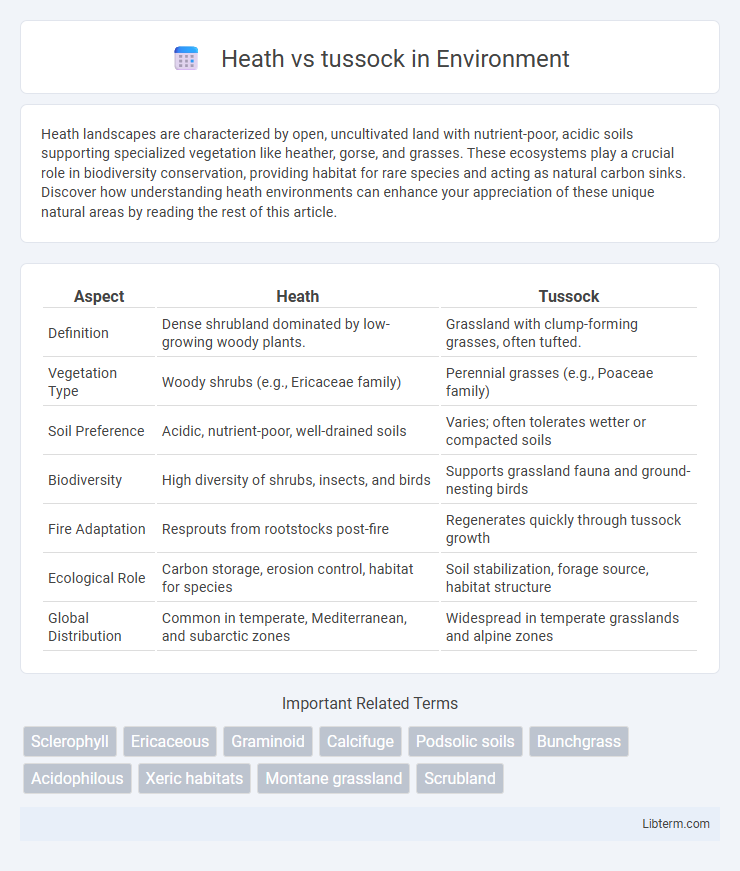Heath landscapes are characterized by open, uncultivated land with nutrient-poor, acidic soils supporting specialized vegetation like heather, gorse, and grasses. These ecosystems play a crucial role in biodiversity conservation, providing habitat for rare species and acting as natural carbon sinks. Discover how understanding heath environments can enhance your appreciation of these unique natural areas by reading the rest of this article.
Table of Comparison
| Aspect | Heath | Tussock |
|---|---|---|
| Definition | Dense shrubland dominated by low-growing woody plants. | Grassland with clump-forming grasses, often tufted. |
| Vegetation Type | Woody shrubs (e.g., Ericaceae family) | Perennial grasses (e.g., Poaceae family) |
| Soil Preference | Acidic, nutrient-poor, well-drained soils | Varies; often tolerates wetter or compacted soils |
| Biodiversity | High diversity of shrubs, insects, and birds | Supports grassland fauna and ground-nesting birds |
| Fire Adaptation | Resprouts from rootstocks post-fire | Regenerates quickly through tussock growth |
| Ecological Role | Carbon storage, erosion control, habitat for species | Soil stabilization, forage source, habitat structure |
| Global Distribution | Common in temperate, Mediterranean, and subarctic zones | Widespread in temperate grasslands and alpine zones |
Heath vs Tussock: Key Differences Explained
Heath and tussock are distinct vegetation types characterized by their plant structure and habitat preferences. Heath consists primarily of low-growing, woody shrubs adapted to nutrient-poor, acidic soils, commonly found in temperate or subarctic regions. Tussock, on the other hand, features dense clumps of grass or sedge, thriving in wet, alpine, or subalpine environments, providing critical soil stabilization and habitat for unique wildlife species.
Defining Heath Landscapes
Heath landscapes are characterized by open, low-growing woody vegetation dominated by heather species such as Calluna vulgaris, thriving on acidic, nutrient-poor soils typically found in temperate regions. These ecosystems support a rich biodiversity adapted to frequent disturbances like grazing and fire, unlike tussock grasslands which are dominated by dense clumps of grass species such as Poa and thrive in different soil and climatic conditions. Understanding the botanical composition and soil chemistry is essential for distinguishing heath landscapes from tussock grasslands in ecological research and land management.
Understanding Tussock Ecosystems
Tussock ecosystems consist of dense clumps of grass or sedge species that create unique microhabitats supporting biodiversity and soil stability, differing significantly from heath environments dominated by woody shrubs. These ecosystems play a crucial role in water regulation, carbon sequestration, and providing habitat for specialized fauna, making them essential for ecological balance. Understanding tussock structure and function aids in managing conservation efforts and mitigating the impacts of land-use change and climate variability.
Plant Species Unique to Heath
Heath ecosystems are characterized by the dominance of plant species such as Ericaceae family members, including heaths (Erica spp.) and heathers (Calluna vulgaris), which are uniquely adapted to nutrient-poor, acidic soils. These species exhibit traits like small, tough leaves and deep root systems that differentiate them from tussock grasses commonly found in grassland habitats. The presence of such specialized plants supports distinctive biodiversity and ecological functions exclusive to heathlands.
Flora and Fauna of Tussock Grasslands
Tussock grasslands are characterized by dense clumps of native grasses such as Poa cita and Festuca novaezelandiae, providing crucial habitat for endemic species like the New Zealand fantail and the endangered Canterbury gecko. These grasslands support a diverse invertebrate community, including ground beetles and moth species adapted to the open, sunny environment. Unlike heathlands dominated by woody shrubs, tussock ecosystems maintain a unique flora-fauna interaction that promotes biodiversity and soil stability in temperate regions.
Soil Composition in Heath vs Tussock
Soil composition in heath ecosystems typically features acidic, nutrient-poor, sandy or peaty substrates with low organic matter content, promoting the growth of ericaceous shrubs adapted to these conditions. In contrast, tussock grasslands often develop on well-drained mineral soils with higher organic content and moderate fertility, supporting dense clumps of coarse grasses. The variation in soil pH, texture, and nutrient availability directly influences the dominant vegetation type and ecosystem structure in heath versus tussock environments.
Climate Adaptations in Both Habitats
Heath and tussock ecosystems each exhibit distinct climate adaptations driven by their environmental conditions. Heath plants often develop sclerophyllous leaves with thick cuticles and deep root systems to conserve water and tolerate nutrient-poor, acidic soils in temperate regions. Tussock grasses adapt to fluctuating moisture levels and temperature extremes through dense clump growth forms and extensive root networks, enhancing soil stability and water uptake in variable climates.
Ecological Importance of Heath and Tussock
Heath and tussock ecosystems provide critical habitat for diverse flora and fauna, supporting species adapted to nutrient-poor and often acidic soils. These vegetation types play a significant role in soil stabilization, water regulation, and carbon sequestration, contributing to climate change mitigation and ecosystem resilience. Their unique biodiversity enhances landscape heterogeneity, promoting ecological interactions essential for pollinators, ground-nesting birds, and endemic plants.
Human Impact and Land Management Strategies
Human activities such as agriculture, urban development, and grazing have significantly altered heath and tussock ecosystems, often leading to habitat fragmentation and loss of biodiversity. Effective land management strategies include controlled burning, invasive species control, and restoration planting to maintain ecosystem balance and support native species resilience. Integrating community involvement and sustainable grazing practices enhances ecosystem recovery and long-term conservation success.
Conservation Challenges: Heath vs Tussock
Heath ecosystems face conservation challenges such as nutrient enrichment, invasive species encroachment, and frequent fire regimes that disrupt native plant communities. Tussock grasslands battle habitat fragmentation, overgrazing by livestock, and altered fire frequencies which threaten their biodiversity and soil stability. Both habitats require targeted management strategies to maintain ecological balance and protect endemic species under escalating environmental pressures.
Heath Infographic

 libterm.com
libterm.com